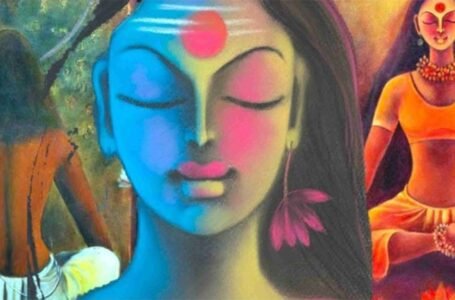Mata ni Pachedi: The Sacred Cloth Painting of Gujarat

Mata ni Pachedi is a unique and ancient form of sacred cloth painting originating from Gujarat, India. Literally meaning “behind the Mother Goddess,” this traditional art form serves as a portable shrine for devotees who do not have access to temples. Created primarily by the Vaghari community, these hand-painted textiles are deeply intertwined with the worship of goddesses, particularly those associated with folk traditions. Over centuries, this intricate craft has evolved but now faces the threat of decline due to the increasing replacement of hand-painted pieces with machine-printed alternatives.
The origins of Mata ni Pachedi can be traced back to at least 300-400 years ago when the Vaghari community, considered socially and economically marginalized, was often denied entry into temples. In response, they devised a creative and spiritual solution: they painted elaborate images of goddesses on cloth, which could then be used as makeshift shrines. These cloth paintings allowed the community to continue their devotional practices without relying on temple structures.
The creation of a Mata ni Pachedi is a meticulous process involving natural dyes, hand-drawn motifs, and traditional techniques passed down through generations. The process consists of several intricate steps:
Fabric Selection: Cotton cloth is chosen as the base material. It is first washed thoroughly to remove starch and other impurities, ensuring better absorption of dyes.
Outlining the Design: The central figure of the goddess is drawn first, often seated on a throne or in a divine posture, surrounded by devotees, animals, celestial beings, and decorative patterns.
Natural Dyes and Colors: Traditionally, artists use dyes extracted from plants, minerals, and other organic sources. Black color is derived from jaggery mixed with iron, red from tamarind seeds, and yellow from turmeric.
Wax Resist and Dyeing: In some versions, the cloth undergoes a resist-dyeing technique to enhance the vibrancy of colors.
Fine Detailing: Artists add intricate details using fine brushes, highlighting the goddess’s attributes, facial expressions, ornaments, and surrounding elements.
Final Touches: The cloth is boiled to fix the colors, ensuring longevity and durability.
Mata ni Pachedi paintings are rich in symbolism. The goddess, often depicted in her fierce and benevolent forms, is the central figure. Common themes include Kali, Durga, Bahuchara Mata, Meldi Mata, and Khodiyar Mata, each revered by different communities. These depictions not only serve as sacred imagery but also convey narratives of strength, protection, and fertility.
Other recurring motifs include animals (lions, elephants, peacocks) symbolizing power and grace, as well as natural elements such as trees and rivers, reinforcing the connection between divinity and nature.
Mata ni Pachedi is not just a form of artistic expression but an integral part of religious ceremonies, especially during Navratri and other goddess-centric festivals. These cloth paintings are often displayed in temples, homes, and community spaces during worship and rituals. Devotees believe that offering prayers to the goddess through these paintings brings blessings, prosperity, and protection.
During the annual fairs dedicated to goddesses in Gujarat, such as those at Ambaji and Bahucharaji, Mata ni Pachedi paintings are prominently displayed and revered.
Despite its historical and cultural importance, Mata ni Pachedi is increasingly becoming a rare art form. Several factors have contributed to its decline:
Introduction of Machine-Printed Reproductions: The commercialization of religious art has led to the rise of printed Mata ni Pachedi textiles, which are cheaper and faster to produce. This has significantly reduced the demand for hand-painted originals.
Loss of Traditional Knowledge: With younger generations shifting towards modern occupations, the knowledge and skills associated with this art form are at risk of being lost.
Market Competition and Economic Struggles: The labor-intensive nature of Mata ni Pachedi means that artists struggle to compete with mass-produced versions in terms of price and accessibility.
Limited Awareness and Appreciation: Outside Gujarat, awareness of Mata ni Pachedi remains limited, making it difficult for artisans to find wider markets and patrons.
Environmental Challenges: The use of natural dyes and the manual processing of cloth require specific conditions, which are increasingly difficult to maintain due to pollution and industrialization.
In recent years, various initiatives have been undertaken to revive and sustain Mata ni Pachedi. Some of these efforts include:
Government and NGO Support: Organizations such as the Gujarat State Handicrafts Development Corporation and various art collectives are working to promote and preserve this traditional art.
Exhibitions and Online Platforms: Museums, art galleries, and e-commerce platforms have started showcasing Mata ni Pachedi, helping artisans reach global audiences.
Skill Development Workshops: Artisans are conducting training programs to pass on their knowledge to younger generations and art enthusiasts.
Fusion with Contemporary Art: Some artists are experimenting with Mata ni Pachedi motifs in modern fashion, home décor, and textile design, creating a new market for the craft.
Mata ni Pachedi is more than just an art form; it is a sacred tradition that embodies the spiritual and cultural essence of Gujarat’s folk heritage. Created by the Vaghari community as a response to social exclusion, it became a powerful means of worship, storytelling, and artistic expression. Each piece reflects deep devotion, meticulous craftsmanship, and a profound connection between the divine and the natural world. Over centuries, this art has not only served as a religious artifact but also as a symbol of resilience and identity for marginalized communities.
However, like many traditional crafts, Mata ni Pachedi faces an uncertain future. The encroachment of mass production has led to a sharp decline in the demand for hand-painted originals. Machine-printed textiles, though inexpensive and widely available, lack the authenticity, uniqueness, and spiritual essence of their handcrafted counterparts. As a result, many artisans find it challenging to sustain their livelihoods, and younger generations are hesitant to continue the painstaking work of their ancestors. Economic constraints, changing consumer preferences, and the increasing commercialization of religious art have further exacerbated the problem.
The loss of traditional knowledge poses another critical challenge. Mata ni Pachedi is not just about painting on cloth; it is a centuries-old tradition deeply rooted in rituals, mythology, and cultural symbolism. If artisans abandon this craft, a valuable repository of indigenous wisdom and artistic heritage may be lost forever. Additionally, environmental challenges, such as the declining availability of natural dyes and the effects of pollution, have made it harder to maintain the traditional processes that define the authenticity of this art form.
Despite these challenges, several efforts are being made to preserve and revitalize Mata ni Pachedi. Government organizations, NGOs, and independent art collectives are working to promote this craft through exhibitions, skill development programs, and financial support for artisans. The growing interest in handmade, sustainable, and culturally rich products has also opened new avenues for Mata ni Pachedi in contemporary markets, including fashion, interior design, and modern textile art. Digital platforms now allow artisans to reach a global audience, providing them with opportunities beyond local fairs and religious festivals.
Ultimately, the survival of Mata ni Pachedi depends on collective action. By raising awareness, supporting artisans, and fostering appreciation for handmade traditional art, we can ensure that this sacred craft continues to thrive. If given the right recognition and opportunities, Mata ni Pachedi has the potential to flourish as both a cultural legacy and a contemporary artistic expression, inspiring generations to come.


